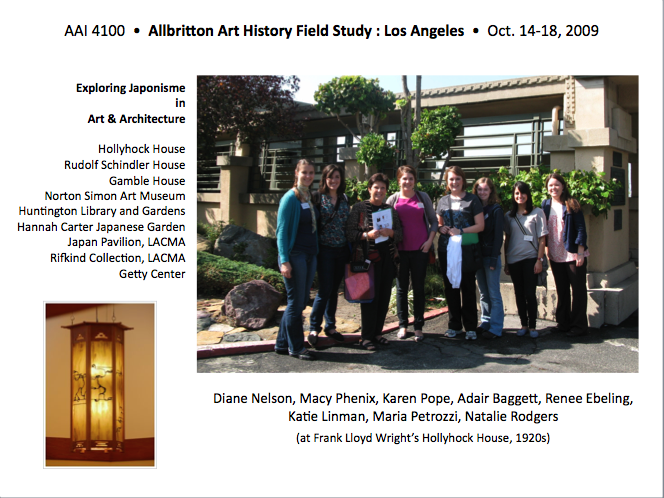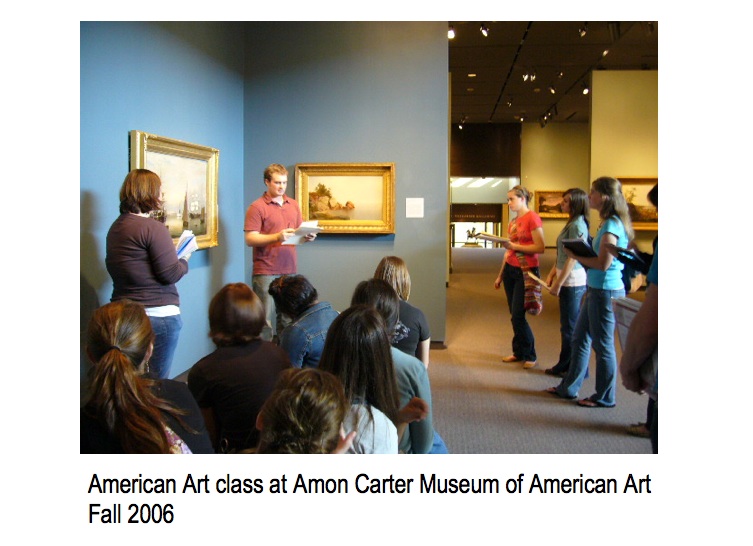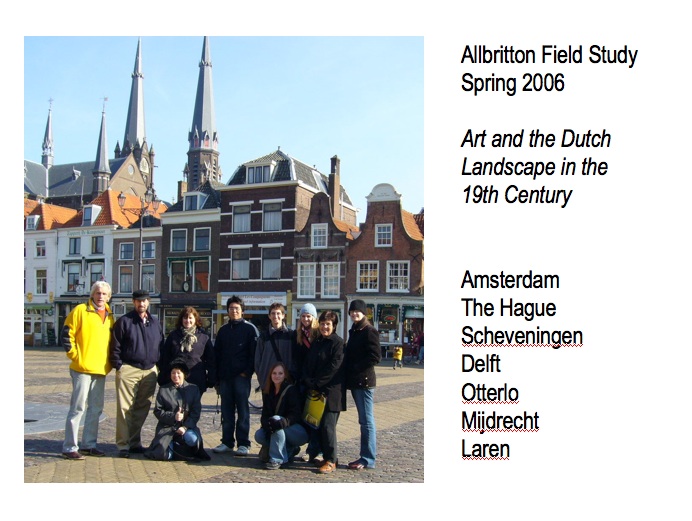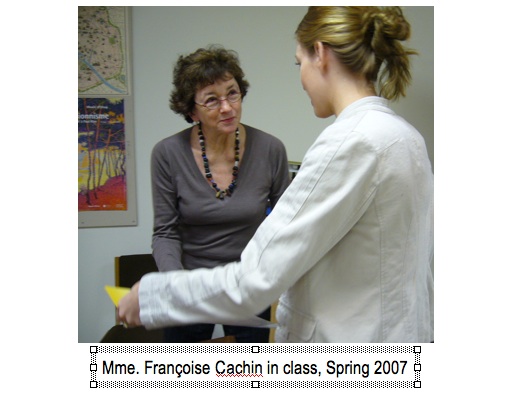ART 4100—ALLBRITTON FIELD STUDY, Fall 2013 (Oct 10-13)
English and Modern European Masters @ Wilmington and Philadelphia
Students in two art history courses traveled together to pursue projects begun at the beginning of the semester in the classroom.
ART 4100—ALLBRITTON FIELD STUDY, Spring 2013 (Mar 9-16) :: Belgium
Symbolism, Fin-de-Siècle, Art Nouveau
The Flemish and Wallonian provinces that became Belgium in 1830 boast an artistic heritage that includes high points in the Gothic and Baroque eras: the “Flemish Primitives” around Brugge (Jan van Eyck, Hans Memling, etc.) and the Baroque masters around Antwerp (Rubens et al.). Following Belgian nationhood, two generations of artists (Claus, Rysselberghe, Ensor, Khnopff, Spilliaert) and their literary friends (Rodenbach, Maeterlinck, Verhaeren) formed a robust Symbolist movement at the end of the century. Students explored the work of major 19th-century Belgian artists in Brugge, Ghent, Antwerp, Oostende, and Brussels.
ART 4100: Allbritton Field Study 2012 to MILAN
In collaboration with Dr. Sharon Hecker, scholar of Milanese sculptor Medardo Rosso (and Academic Dean and Adjunct Professor, Università Cattolica del Sacro Cuore, Milan), this course explored the ways in which artists contributed to the formation of an Italian identity following the unification of Italy in the 1860s. Students explored patriotic collections and monuments and became acquainted with the specifically Milanese references found in Liberty Style architecture. Individual projects focused on key figures of Milanese modern art, from the Scapigliatura to the Futurists.
6 days in Vienna emphasized the great art collections, architecture, and unique expressions of modern art in the context of end-of-the-century Viennese culture.
Students conducted projects before the travel portion of the course and completed planned assignments while in Vienna. The ultimate goal of the Field Study: develop an understanding of Gustav Klimt, Josef Hoffmann, Koloman Moser, and the circle of painters, architects, sculptors and designers known as Secessionists—artists who declared a bold separation from the art establishment of their youth—and to explore key examples of their work, many of which still exist in their original contexts.
Degas in LA: For a weekend study tour focused on Degas, the great Japoniste
Edgar Degas (1834–1917) was one of the first artists collected by the American industrialist, philanthropist, and art collector Norton Simon (1907–1993). Over the course of nearly three decades of art acquisition, Simon purchased more than a hundred works by Degas, including paintings, bronzes, and pastels. This comprehensive and beautiful collections catalogue of the artworks by Degas now housed in the Norton Simon Museum in Pasadena, California, offers not only a fascinating insight into the evolution of Simon’s extensive and remarkable collection of pieces by the French impressionist, but also a descriptive and informative account of the current collection prepared by leading Degas scholars. (Sara Campbell, et al., Degas in the Norton Simon Museum Nineteenth-Century Art, Yale University Press, 2009)
Venice: A Visitable Past
In the 19th century, virtually all intelligent travelers paid at least one visit to Venice. Although Napoleon had brought “La Serenissima” to an end, Venice–the compelling physical uniqueness of the city, the affordability of the distressed city as a destination in the 1800s, and the richness of the visual arts in their incomparable setting–attracted writers and painters who created a rich legacy of the city Henry James called “the city with a visitable past.” Students in the Spring 2010
Allbritton Field Study explored the Venetian works of 5 of these important 19th-century visitors and, in Venice, on foot and by water, developed deeper understanding of these artists by finding their motifs and considering the choices the artists made as could be pondered by locating their worksites.
“Japan & the West”
In the second half of the 19th century, trade between Japan and the West created great interest in the arts of Japan, which led to collections, dealers, exhibitions, and the appearance of qualities of Japanese art in Western painting, prints, furniture, architecture, and decorative arts. Students in the Fall 2009 course called “Japan & the West” traveled to Los Angeles where they studied Japonisme in the visual arts and explored three important architectural examples of Japonisme. Special meetings at LACMA with the curator of the Japan Pavilion and the librarian of the Rifkind Center for German Expressionist Studies enriched the group’s acquaintance with key aspects of Japanese art and gave a vivid introduction to Japonisme as a phenomenon of German Expressionist graphic art.

William Sidney Mount and American Genre Painting on Long Island
Three-quarters of the work of William Sidney Mount, the first major painter of American life, belongs to The Long Island Museums at Stony Brook. Students of American art chose topics concerning Mount and his contemporaries, then explored the museums and landscapes of Long Island to enrich their understanding of 19th-century American art.
Constable Country and the English Landscape
Students in the 19th-Century European Art course who participated in the Allbritton Field Study to England prepared by studying the work of John Constable and the collections where his paintings and drawings can be seen; in England, we studied the paintings, then visited Stonehenge and Stourhead (primeval and designed landscape), then explored Constable Country where we found his motifs and considered his subjects, range, and realism.
Japonisme and Nineteenth-Century Printmaking
Students in the course on 19th-century prints who were interested in hands-on study of works by important printmakers participated in the Fall 2007 AAI Field Study to Chicago. Early in the semester, each student prepared presentations about key monuments we would see in Chicago, then focused on the printmaking career of one selected artist (our 5 artists were Bracquemond, Buhot, Gauguin, Pissarro, and Vallotton). The Art Institute of Chicago welcomed us for a morning in the Print Study Room where each student spent over an hour with four pre-selected prints by her artist. Although this was, academically, the most rich and intense portion of the field study, many other aspects of the weekend in Chicago made the trip a rewarding and memorable experience in the study of 19th-century art, e.g., visiting the site of the Columbian Exposition (1893) and exploring the first generation of skyscrapers (1890s).
Art and the Dutch Landscape in the Nineteenth Century
The AAI Field Study to the Netherlands in spring, 2006, focused on the landscape painters known as The Hague School. Students prepared reports beforehand on places and monuments we would see on tour and made in-depth studies of key artists whose works and motifs we would explore in and around Amsterdam. One student was able to locate and discuss Amsterdam subjects in the paintings of Georg Breitner; another worked on the early landscape art of Piet Mondrian. The picture below was taken in Delft, city of Vermeer and Porceleyn Fles, the oldest of the “Delft” factories where a tour illuminated pottery-making in the 19th-century town.
Allbritton Daytrips
An important part of each upper-level course in 19th-century art is a daytrip to a central-Texas art museum in which the entire class participates. Students choose artists and key works in the destination museum and give short gallery talks.

Allbritton Annual Lecture
The Allbritton Art Institute sponsors an annual lecture by a major scholar about a 19th-century topic one year, a 20th-century topic the next. Mme. Françoise Cachin, Director emerita of the Museums of France, delivered the 2007 Allbritton lecture, speaking about “Self-Portraits, Manet to Gauguin.” She conversed with the Impressionism/Post-Impressionism class the next morning and autographed her lecture posters.










